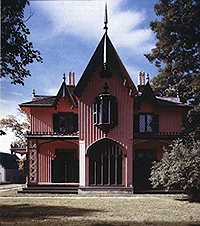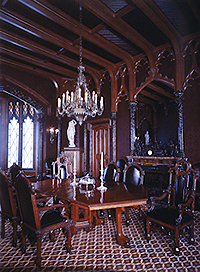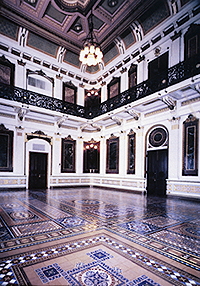
East facade of the Henry C. Bowen summer cottage, Woodstock, Conn. designed by Joseph Wells (1814-1816), built in 1846.

East facade of the Henry C. Bowen summer cottage, Woodstock, Conn. designed by Joseph Wells (1814-1816), built in 1846.

Henry C. Bowen house, Woodstock, Connecticut, 1846 double parlor. The Lincrusta Walton wallcovering and plaster ceiling medallion probably date from the redecoration of the 1880s.

Kingscote library, 1839. Architect: Richard Upton. The house was bought in 1863 by William Henry King when the Jones's (original owners from Savanna, Georgia) sold following the Civil War. The Kings were China trade merchants as reflected in the library furnishings.

Dining Room from Lyndhurst, Terrytown, N.Y. by Alexander Jackson Davis of New York. Circa, mid Nineteenth Century.

The Henry Clay Bedroom, with its Gothic Revival furniture, Rosedown, Louisiana. By Philadelphia furniture maker Crawford Riddell, circa 1844.

Armoire from bedroom suite originally made for Henry Clay, but seen here at Rosedown Plantation, Burnside, Louisiana.

The Ralph Jacobs House, formerly on S.W. Park, Portland, OR. Architect: Warren Williams, Italian Villa Style, built in the early 1880s. Oregon Historical Society photograph.

View of the entry and stair hall, Isaac Jacobs House, formerly S.W. Park, Portland OR (next to the Ralph Jacobs House). Architect: Warren Williams, Italian Villa Style (a mirror image of the Ralph Jacobs House). Circa, early 1880s. Oregon Historical Society photograph.

Old Executive Office building, Washington, DC. Architect: Alfred B. Mullett. The granite French Second Empire Style structure was once home to the State, War, and Navy Departments. Circa 1875.

Old Executive Office building, A.B. Mullett. Grand Reception room of the Navy Library.

Deady Hall, William W. Piper of Portland, architect. French Second Empire Style, circa 1876.

William Carson House, Eureka, California. Architect: Samuel and Joseph C. Newsom of San Francisco. Queen Anne Revival Style, circa 1885.

Parlor fireplace with Mexican onyx mantle. Carson House, Eureka, California. Samuel and Joseph C. Newsom. Note: stained glass windows were often a feature of Queen Anne houses. The one shown here requires that the flue be diverted to one side.

Rosewood armchair and side chair from a set made by John Henry Belter and owned by Abraham Lincoln. American Rococo Revival Style, circa 1850. Note Belter's patented laminating process and the appearance it gives to the back of the chairs.

This Victorian parlor at Fountain Elms, built in 1850 at Utica, New York has furniture in the Rococo Revival Style.

Pier table with display cabinet, maker unknown, United States, circa 1865-1875. Mahogany inlaid with walnut, maple, birch, and exotic woods. American Renaissance Revival Style.

Armchair of walnut by Thomas Brooks and Son of New York. American Renaissance Revival Style.

Sofa made by John Jelliff and Company of Newark, New Jersey, circa 1865-1870. Rosewood with Mother of Pearl inlay. Note: carved bell flowers at the corners of the back are characteristic of John Jelliff's seating furniture. Renaissance Revival Style.

Richard Reutlinger House, San Francisco, circa 1870. Bedroom restored and furnished in American Renaissance Revival taste. Note the density of the furnishings.

Detail of joint between drawer front and sides using the Knapp dovetailing machine. This type of joint is most common on Renaissance Revival furniture and was extensively used during the 1870s, 80s, and 90s, in the United States.

American Renaissance Revival organ case in the Methuen Memorial Music Hall in Methuen, Mass. Organ by E.F. Walcker and Co. of Germany; the American black walnut case was made by Gustave Herter between 1860 and 1863 in New York City.

Wooton desk, one of many patented pieces designed by William S. Wooton of Indianapolis, Indiana. Circa 1870.

Of the American Victorian experimental furniture, one of the finest designs was for this rocking chair, circa 1860, by Peter Cooper. It utilizes painted strap iron for its frame and is a forerunner to some modernist furniture of the 20th century.
The copyright law of the United States (Title 17, United States Code) governs the making of photocopies or other reproductions of copyrighted material. The University of Oregon adheres to this statute by relying on the fair use provisions of the copyright law and by obtaining permission of the copyright holder where applicable. One of the conditions of the copyright law as it applies to libraries specifies that a photocopy or reproduction is not to be used for "any purpose other than private study, scholarship, or research. A user may be liable for copyright infringement if a user makes a request for, or later uses, a photocopy or reproduction for purposes in excess of "fair use," or for purposes prohibited by the stated terms and conditions set by a publisher or vendor.